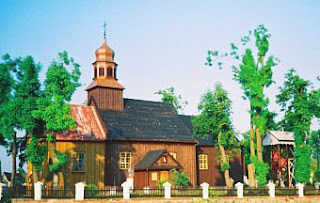Kujawy – Straszewo Parish History
Hello,
This is my second post that will deal with the parishes in the Kujawy region of Poland. The Straszewo Parish is located within the Gmina Koneck, which is in Powiat Aleksandrow. I have  tried to translate the history of this parish with various translating tools, which include books and online tranlation websites. Any errors in this translation are my own. The translation from the parish website is below:
tried to translate the history of this parish with various translating tools, which include books and online tranlation websites. Any errors in this translation are my own. The translation from the parish website is below:
(Picture 1)
 From the evidence available, it shows that the first church in Straszewo was
From the evidence available, it shows that the first church in Straszewo was built at the turn of the thirteenth or fourteenth century. The current church that was built in the year 1781 was the fourth church that was built in Straszewo. The Teutonic Knights burned the first church at the end of the fourteenth century. The second church that was reconstructed by Bishop Matthias Łubieński was destroyed in-between 1631 – 1641 during the Swedish Deluge. In 1687, the Archdeacon of Włocław, Stanisław Niemierza, rebuilt the church. This church burned after close to 100 years of service. In 1781, the Włocław chapter rebuilt the church and it has survived since.
built at the turn of the thirteenth or fourteenth century. The current church that was built in the year 1781 was the fourth church that was built in Straszewo. The Teutonic Knights burned the first church at the end of the fourteenth century. The second church that was reconstructed by Bishop Matthias Łubieński was destroyed in-between 1631 – 1641 during the Swedish Deluge. In 1687, the Archdeacon of Włocław, Stanisław Niemierza, rebuilt the church. This church burned after close to 100 years of service. In 1781, the Włocław chapter rebuilt the church and it has survived since.
An interesting fact is that the main altar was the altar from the Włocław cathedral and was given  as a gift for timber, from the Straszewo forests, to build pillars for the cathedral. The historical richness can be seen from the iron that riveted the door leading from the sacristy to the sanctuary. The iron has survived all of the fires and storms. Also, fragile stone bowls have visible channel marks
as a gift for timber, from the Straszewo forests, to build pillars for the cathedral. The historical richness can be seen from the iron that riveted the door leading from the sacristy to the sanctuary. The iron has survived all of the fires and storms. Also, fragile stone bowls have visible channel marks that were incurred when Polish Knights wiped their swords before they entered and exited the church.
that were incurred when Polish Knights wiped their swords before they entered and exited the church.
During the recent renovation work, it turned out that in the presbytery are crypts. It is assumed that these are the tombs of the church founders.
The Church in Straszewo was still in service during World War II. The German Commissioner lived at the rectory during the war, and in the last days of the war he shot himself in the head. The leading SS investigators  found a short note in which he wrote regarding his suicide, “I do not want to have nothing in common with Hitler’s genocide”. Then the parish priest, who was accused of the murder, was freed from being put in front of the wall and shot. (A German priest, who had a working relationship with the parish priest, learned about this letter’s content from one of the German soldiers and delayed the execution until the next day).
found a short note in which he wrote regarding his suicide, “I do not want to have nothing in common with Hitler’s genocide”. Then the parish priest, who was accused of the murder, was freed from being put in front of the wall and shot. (A German priest, who had a working relationship with the parish priest, learned about this letter’s content from one of the German soldiers and delayed the execution until the next day).
Sources:
History and Picture 1: http://web.diecezja.wloclawek.pl/parafia/straszewo/historia.html
Pictures: http://web.diecezja.wloclawek.pl/parafia/straszewo/g1/index.html
Best Regards,
Al.

